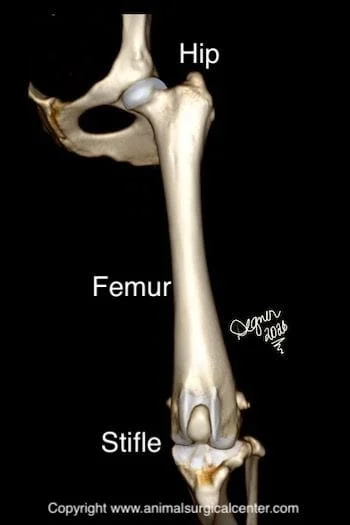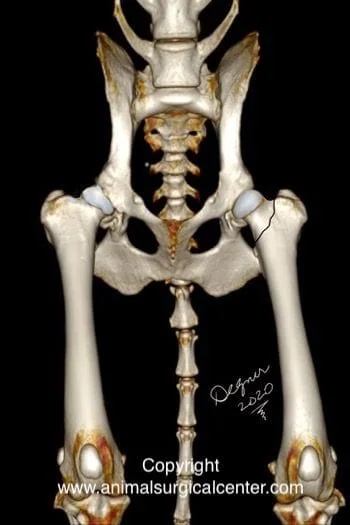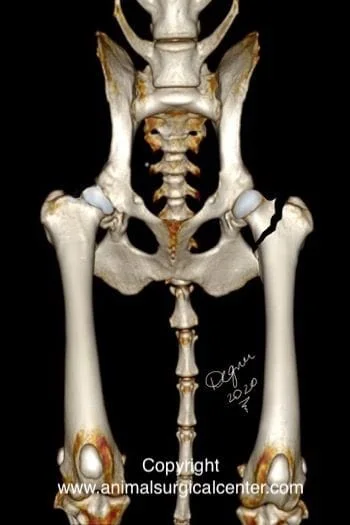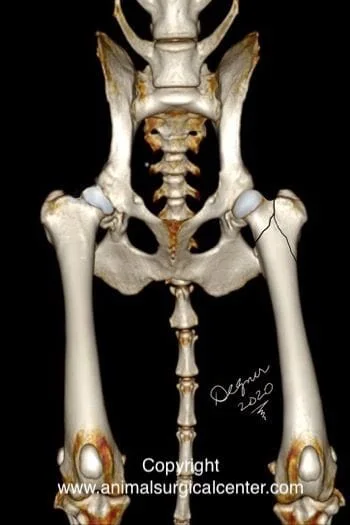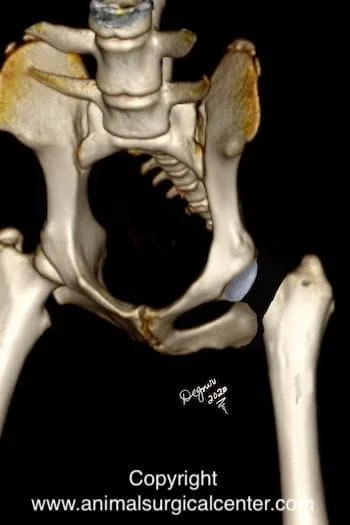Key Points
Fractures of the hip occur in immature cats and dogs
Surgery is the best option to repair hip fractures
The prognosis is fair to good with this type of surgery
Initial visit- downloadable forms/information for clients:
History sheet - Client initial consultation history
Femoral neck and proximal metaphysical fracture client education handout
Discharge instructions for postop fracture care - dogs
Discharge instructions for postop fracture care - cats
2-week recheck visit - downloadable forms/information for clients:
Postop care instructions 2-week Fracture repair recheck - dog
Postop care instructions 2-week Fracture repair recheck - cat
Postop care instructions 2 week -FHO recheck (Telemed) - dog
Postop care instructions 2-week FHO recheck (Telemed) - cat
8-week recheck visit - downloadable forms/information for clients:
History form 8-week fracture recheck (in hospital)
Postop care instructions 8-week fracture repair recheck - dog
Postop care instructions 8-week fracture repair recheck - cat
Downloadable forms for referring veterinarians:
Anatomy
The top or proximal part of the femur bone consists of the femoral head, femoral neck, greater trochanter, lesser trochanter and the metaphysis. The femoral head articulates with the acetabulum or the cup of the hip joint.
Cause of fracture
A fracture is synonymous with a broken bone. When a fracture occurs through this region of the bone the hip joint is no longer functional. The most common cause of a femoral fracture is trauma such as being struck by a motorized vehicle or taking a fall.
Signs
Sudden onset of severe to nonweight-bearing lameness is common in patients sustaining a proximal femoral fracture. Palpation of the hip will elicit pain and a grating or clicking sensation may be felt when moving the hip joint.
Diagnosis
The diagnosis of a proximal femoral fracture requires x-rays; typical x-ray views include the hip extended, frog-leg, and lateral views. Sometimes the fractures of the proximal femur are multiple and a CT scan is ideal to further assess the extent of the fracture and to plan the surgical repair. Other testing that may be recommended prior to anesthesia includes a complete blood count and chemistry profile to ensure that the pet is healthy. If the fracture was due to trauma such as being hit by a motor vehicle, chest x-rays should be made to rule out lung and chest trauma.
Preparation for surgery
The pet should be fasted prior to surgery, as instructed by the surgical team. Water is usually permitted up to the time of admission to the hospital. The surgical team should be informed of any medications that your pet is currently receiving. Just prior to surgery, your pet will receive a sedative, have an intravenous catheter placed for the administration of intravenous fluids and intravenous medications, be induced under general anesthesia with medication(s), and have a breathing tube (endotracheal tube) placed to allow delivery of oxygen and gaseous anesthesia. The surgical site will be clipped and cleansed with an anti-septic solution in preparation for surgery. While under general anesthesia, the pet’s breathing will be assisted with a ventilator and vital parameters such as heart rate, respiratory rate, core body temperature, blood pressure, oxygenation of the blood (pulse oximetry), exhaled carbon dioxide (capnography), and heart rhythm (EKG) will be monitored to ensure the pet’s well being. Pain will be controlled both during and after surgery with analgesics (pain-controlling medication). Please note that each surgical and anesthesia team may elect to chose a different, but effective analgesia protocol.
Surgery
Femoral neck and metaphyseal fractures always require surgery for a successful outcome. The surgery should be done as soon as possible so that excessive scar tissue does not build up, thus preventing the fracture from fitting together properly. In medium to large dogs, primary repair of the fracture is always recommended. Generally at least one screw and a pin or two screws are used to repair this type of fracture.
In some cases, the femoral neck fracture and proximal metaphyseal fracture is present and requires a much more elaborate method of fixation which typically includes a series of screws and a metal plate that is placed on the side of the bone.
In small dogs and cats, femoral head and neck osteotomy can be performed to treat a femoral neck fracture fracture and the results are usually good. In this procedure, the piece of broken bone (femoral cap) is removed and the remaining portion of the femoral neck is excised (see illustration right.
Aftercare
After surgery, you can continue to give your pet a prescribed pain reliever to minimize discomfort. It’s also extremely important to limit your dog’s activity and exercise level during this post-operative period. A sling will be placed on your companion’s hind limb to prevent weight-bearing during the first 10-14 days after surgery. Rehabilitation exercises can be done at your home or if you choose, by professionally trained therapists at an animal rehabilitation center. Rehabilitation therapy should be continued until your dog is bearing weight well on the operated limb (typically 2 – 4 weeks after surgery). Detailed instructions will be given to you after the surgery. The surgeon will monitor the healing process with two follow-up exams. The first is scheduled at two weeks after the surgery and the second is at eight weeks after the surgery. By 8 to 10 weeks after surgery, most dogs are fully weight-bearing on the operated limb, although exercise should be limited during the first three months after the procedure.
Prognosis
Primary repair of the fracture has a good outcome in most cases, whereas, no surgery will result in persistent lameness and hip pain. In general most small dogs and cats that receive a femoral head and neck excision surgery regain very good function on the limb.
Uncommon complications include infection, breakage of the pins, failure of healing of the bone, and sciatic nerve damage.


